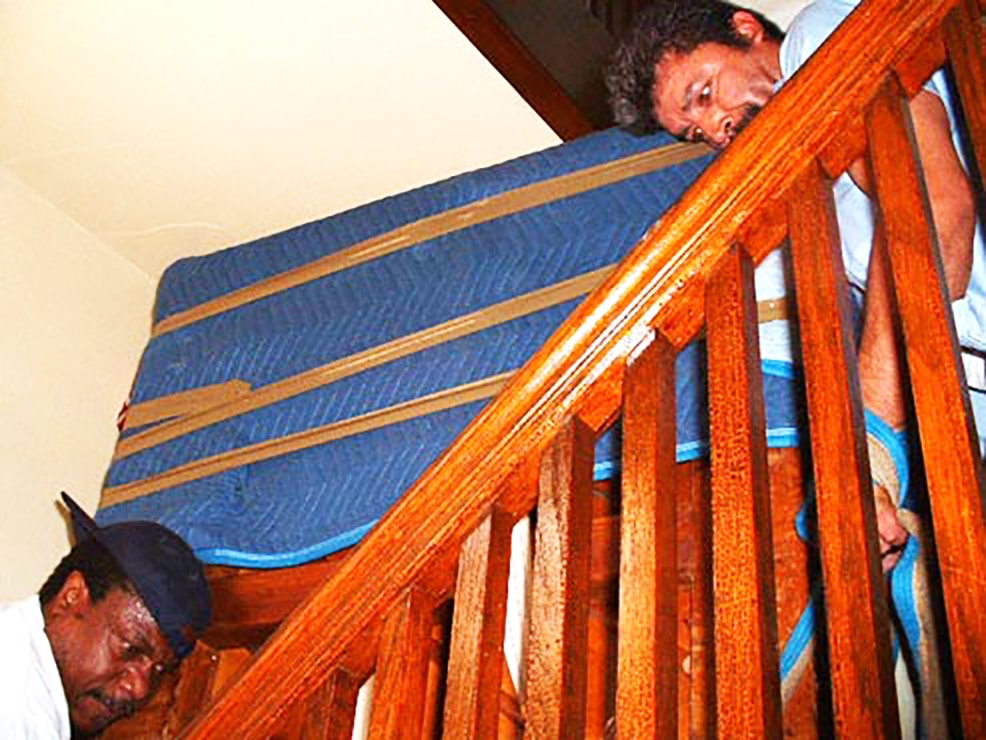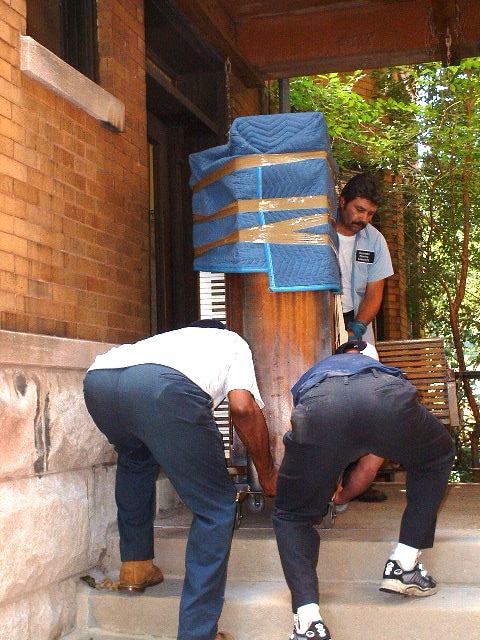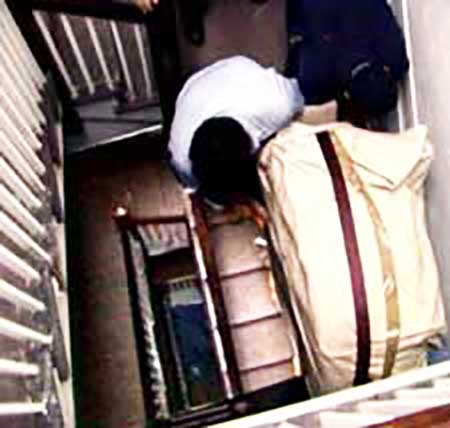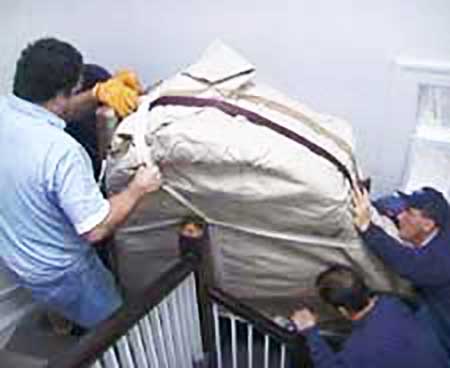Warnings of Dangers When Moving a Piano
Because of the risks of piano moving, if you’re going to have to move your piano over 4 low consecutive low steps at any given point in the
The piano moving risk is huge when traversing more than 4 consecutive low steps because then you have to actually carry the piano, not just tip and ease it up or down! The danger and the risk of piano moving are really, really high.
So, just pay a qualified professional piano mover to do it for you!
But if you will not be traversing over 4 consecutive low steps in your entire move path and / or if you still want to further investigate how to move your piano yourself, then read on.
We feel that it is our responsibility, in consideration of your personal safety, to first make every attempt to warn you of the many piano moving risks involved in do it yourself piano moving.
We are giving you these warnings because we’re certain that you may not fully realize the dangers to which you are about to become exposed.
Consequently, we ask you to carefully and completely read everything on the rest of this page. Please don’t skim by any of it! These warnings cover all of the necessary piano moving safety and cost issues in order for you to make an informed, intelligent decision on this important matter.
Then, having learned that piano moving is risky, if you still desire to move your own piano, this internet piano moving guide will teach you the piano moving techniques that you will want and need to know to accomplish your piano move successfully.
First, please start off by observing the picture below very carefully

Then imagine putting yourself into the same position as any one of these 3 movers as they are starting to carry 800 heavy-ass lbs. of big upright piano down these stairs!!
Just look at it! When you first put yourself underneath a sizable piano like this one, which is positioned at the top of a long stairway, it will look to you like the Sears Tower!
Then, when you actually start to carry it, you’ll think you’re lifting the Sears Tower!
Next, imagine that once you do get started carrying it, the weight of this monster piano begins to overwhelm any one of you and it starts to wobble around over you as you’re each desperately trying to steady it or set it down onto a step to regain control of it!
Then, supposing that it in the midst of your desperate efforts to regain control of it, it suddenly gets away from one of you completely!
Those of you on the bottom would have to frantically try to leap out of the way in order to avoid personal injury. Then, even if both bottom people do somehow miraculously escape injury, the piano and the stairway and the railing are still going to end up being severely damaged.
What a horrible nightmare scenario that can occur when you’re just trying to save a few bucks!
Are you absolutely certain that this task would not be better left to those trained to do it, even if they charge you a few hundred dollars?
Normally, do it yourself piano moving involves a high degree of risk of injury to the crew and / or damage to the piano / property versus a very small potential for money savings compared to having a professional do it for you.
We strongly recommend against do it yourself piano moving over 4 consecutive low steps in the move path because pianos are heavy and extremely difficult to balance and carry.
If your movers are not constantly diligent to use proper technique every step of the way, it’s very easy to have any size piano suddenly get away from them with a resulting nightmare moving day catastrophe!
Next, please carefully observe the picture below.

Notice the intensity of the strain upon the faces of these 2 skilled piano movers as they carry this piano down the stairs (which is a heck of a lot easier than carrying it up them)! The top man is working hard to hold the piano back (with his strap under the piano) so that its weight is not totally upon the two bottom men (one is unseen but straining just as intensely on the other side of the piano). The 2 bottom men are working together to keep the piano in balance between themselves and the top man as they carry it down the stairs.
Do you, as amateurs, really want to take the risk that these 3 highly experienced professionals are taking here?
If you don’t entirely agree with us about the extent of the risk involved and you go on to further search the internet to seek advice from other piano movers, you will find that they’ll all concur with us. Why? Just to get you to spend your money on their services? Maybe? To some degree greed might be involved in their advice to you, but we prefer to believe that they (as we) are more interested in people’s welfare. All piano movers know from their personal experience (as we do), the inherent risks and dangers of piano moving.
Think about it. Considering all of the potential dangers of piano moving, are there really circumstances where there is just no other viable choice except that an amateur do it yourself piano moving crew must be sought out to move it?
Then let’s look into some circumstances that appear to force people into the danger of piano moving.
Injuries when Moving Yourself
I just can’t afford to spend hundreds of dollars so I’ll have to move my piano myself!
Maybe you can’t, but before you leap ahead too fast trying to save your money by moving your piano yourself, add into your plan the terrible possibility of an unexpected severe injury!
Or can you afford to be off from work and go unpaid for some protracted period of time because during the piano move your back goes out, your knee gets broken, a shoulder socket is permanently disabled, or you break an arm / wrist / hand / finger or a hip / leg / ankle / foot / toe?
How about if that severe injury should instead happen to a friend / relative of yours who is helping you move your piano and he is eventually forced by financial pressures to sue you, thus ruining your relationship?
Then again, supposing the piano is moved without any personal injury to the movers but in the process its sound board is damaged or a big, long, deep scratch is gouged into its fine finish or a caster digs a big divot into your brand new hardwood floor or the deck / porch is damaged from the accumulated weight of the piano and the men.
Now, compared to such bleak scenarios as these or the terrible piano moving catastrophe, the few hundred dollars that you would have to pay to a professional piano moving company turns into a very inexpensive, excellent bargain, doesn’t it? Yeah, I guess so.
That is if you use a qualified piano mover who can prove to you that they have full workmen’s compensation insurance for their men and full property liability coverage for each residence and for your piano. They’d better!
Piano Moving Techniques
My friends and I are big strong guys. The piano’s not really that big. Look I can lift one end by myself. Sure it’s a little heavy, but with three or four of us it shouldn’t be that hard to move.
You and your illustrious friends might actually be able to move the piano successfully. However, without correct piano moving technique and without a good piano dolly, piano belt and a strong humpstrap, you won’t!
If you’re going to encounter four or less consecutive low steps at any given place in the move path, you’ll be taught to utilize our piano moving techniques of tipping and lifting or lowering the piano on the dolly. In the piano move pictured below but you can see how easy it should be (IF the movers keep careful control of the piano) to move the piano down one step on the dolly as this mover is about to do. In reality it looks a lot easier than it really will be because of the extreme weight of the piano but he does it successfully.

When there are more than four consecutive steps along the move path (as was the case in the piano move pictured below) you’ll have to actually carry the piano as these movers are about to do. A piano carry is necessary because there are 6 consecutive steps to be traversed (not all of the steps shown are shown in the picture) off of this home’s porch.

Having to actually carry the piano raises the difficulty factor of the piano move considerably!
Throughout a piano carry, good balance is necessary and can only be accomplished when the whole crew is working in unison and properly utilizing their piano moving equipment.The part of piano carrying that requires skill and concentration is keeping the piano in balance (not allowing it to wobble) much from left-to-right and / or from front-to-back) while actually carrying it up / down steps.
You or someone on your crew could badly wrench their back or incur any of the injuries mentioned above and / or even heavily damage the piano if it gets severely out of balance and you have to let go of it.
The larger the piano and the more steps involved – the tougher it is to lift it and keep it in balance; therefore, the tougher it is to carry!
Remember, all piano moving dangers come from gravity and inertia constantly fighting you. If the piano doesn’t stay balanced constantly during the moving process, very bad things can happen very, very rapidly, just like in a nuclear meltdown! When the piano starts to go, suddenly there is just no stopping it!
Also, sometimes when moving a piano up/down stairs, a banister has been known to fail right in the middle of the move! If the movers are leaning on it at that time catastrophic things can occur!
In the piano moving trade the person on the bottom holding the main part of the piano and carrying most of the weight is described as the man on “heavy” and he really is!
Even with the smallest piano, the weight that can be dumped onto that bottom person is immense! An unbalanced piano means that 350 – 500 lbs. minimum(!) for a small upright piano and 600 -1000 lbs. for a grand piano or a big upright, can all be mostly dumped onto the guy on heavy!
This is why mover’s backs can go out so easily. Everyone on the crew can be a big strong guy, just like your friends are, but this kind of weight in an unbalanced situation is just humanly impossible for even the strongest man to handle without injury.
When the weight gets to be too much for any member of the team he will just have to let the piano go!
Then, goodbye piano – hello injuries to anybody who does not get out of the way!!!
Now, when you consider how dangerous piano moving is, have you decided that it’s best to not move your piano yourself?
To find a qualified mover in your area.
Four Consecutive Low Steps
Piano moving up or down up to 4 consecutive low steps at any given point in the move path can be accomplished by amateurs by simply using our piano moving techniques of tip and lift or lower that are much easier than having to actually carry the piano.
If, and only if, you and your big, strong friends carefully follow our instructions you should be able to safely move your piano up or down four consecutive low steps or less anywhere in the move path.
Carrying a piano over any more steps than that is another story, however.
Actually carrying a piano forces the amateur out of the comparatively easy realm of the piano moving technique of tip and lift / lower and into the most difficult and dangerous part of piano moving – actually carrying the piano. Traversing more than 4 consecutive low steps at any given point in the move path requires complicated piano carrying techniques.
This is an important warning about piano moving! With large or small pianos, their extreme weight brings such great danger on a piano carry that we 99% advise against amateurs attempting to do it.
Winding / Circular Stairs
This is another important DIY piano moving warning!
If any piano must go up / down winding circular stairs we will not give instruction because in our opinion this situation is just too difficult and dangerous to be attempted by amateurs.
Winding / circular stairs require the piano moving services of highly skilled experienced professionals in order to avoid personal injury and / or to avoid property damage to the stairs or to the piano.

There is just no easy way to move a piano up / down a winding stairway.

There is almost no opportunity for the crew to stop and set the piano down on the steps in the middle of the winding stairway. So, the piano must be carried up / down the winding stairs without stopping which requires exact, precise, top level piano moving technique combined with properly-focused brute strength!
We highly recommend that only trained professionals move pianos up / down winding circular stairs! Please do not do this kind of piano move yourself! This is one of our very important warnings about DIY piano moving!
4-Legged Piano Moving
If your small upright piano has 2 legs in front and also 2 more decorative legs in the back with the case hanging between them (like the one pictured below), then we again highly recommend that only professionals be used. Untrained people cannot handle this style of piano going up / down more than just 1 step at any given point in the move path without a 99% chance of damaging the piano.

The indenting of the piano’s lower casing to accommodate its decorative rear legs interferes with the normal – piano on its side on the dolly – moving procedure used when traversing more than 1 step. As you can see, there is nowhere to place the dolly under this kind of piano’s side without part of the piano overhanging and dragging the ground. Professional piano movers will fill this gap with big phone books.
Because of the difficulties inherent in this particular kind of piano’s design
we highly recommend that amateurs do not attempt to move it if there are 2 or more consecutive steps at any given point in the move path!
Instead, please just pay the trained professional! But before you do, it’s a good idea to know how much professional piano movers will charge for the job. Then once you know what to expect price-wise, you can sit down and decide the best way to move your valuable piano in terms of safety and finances. Take a quick look at the current piano moving costs to better understand the financial challenge you’re up against.
Big Upright Piano Moving

If the piano is a ‘big upright piano‘ (over 48″ high – weighing 500-900 lbs.) or if it is a ‘big upright player piano‘ (increasing the overall weight of the piano by 100 to 200 lbs.), we highly recommend only moving it to / from locations with no more than four consecutive low steps at any given point in the move path.
This is another very important warning about DIY piano moving! Big upright pianos and big upright player pianos are extremely heavy and therefore very dangerous to the people actually doing the piano move.
If more than 4 consecutive low steps at any given point in the move path must be traversed then the piano must be carried by the movers and this extreme dead weight is just beyond what the normal person can bear! Any kind of minor out of balance condition can very quickly and easily put people in the hospital and / or clobber the piano.
Maybe we’re beginning to sound like a broken record but still –
We seriously recommend that big “KILLER UPRIGHTS” only be moved by professional movers, if over four consecutive low steps are going to be encountered at any given point in the move path.
In the moving industry upright pianos taller than 50″ are respectfully referred to as “KILLER UPRIGHTS!”
If you have now decided to not move your piano yourself then find a good piano mover in your area.


